若 API 遵循 RESTful 精神設計,常會第一個 API 僅回傳 id,若要取得其值就要呼叫第二個 API,也就是所謂 N + 1 Query,RxJS 對這種常見需求有很漂亮寫法。
Version
macOS Catalina 10.15.4
WebStorm 2020.1.1
Vue 2.6.11
Vue-rx 6.2
RxJS 6.5.5
Browser
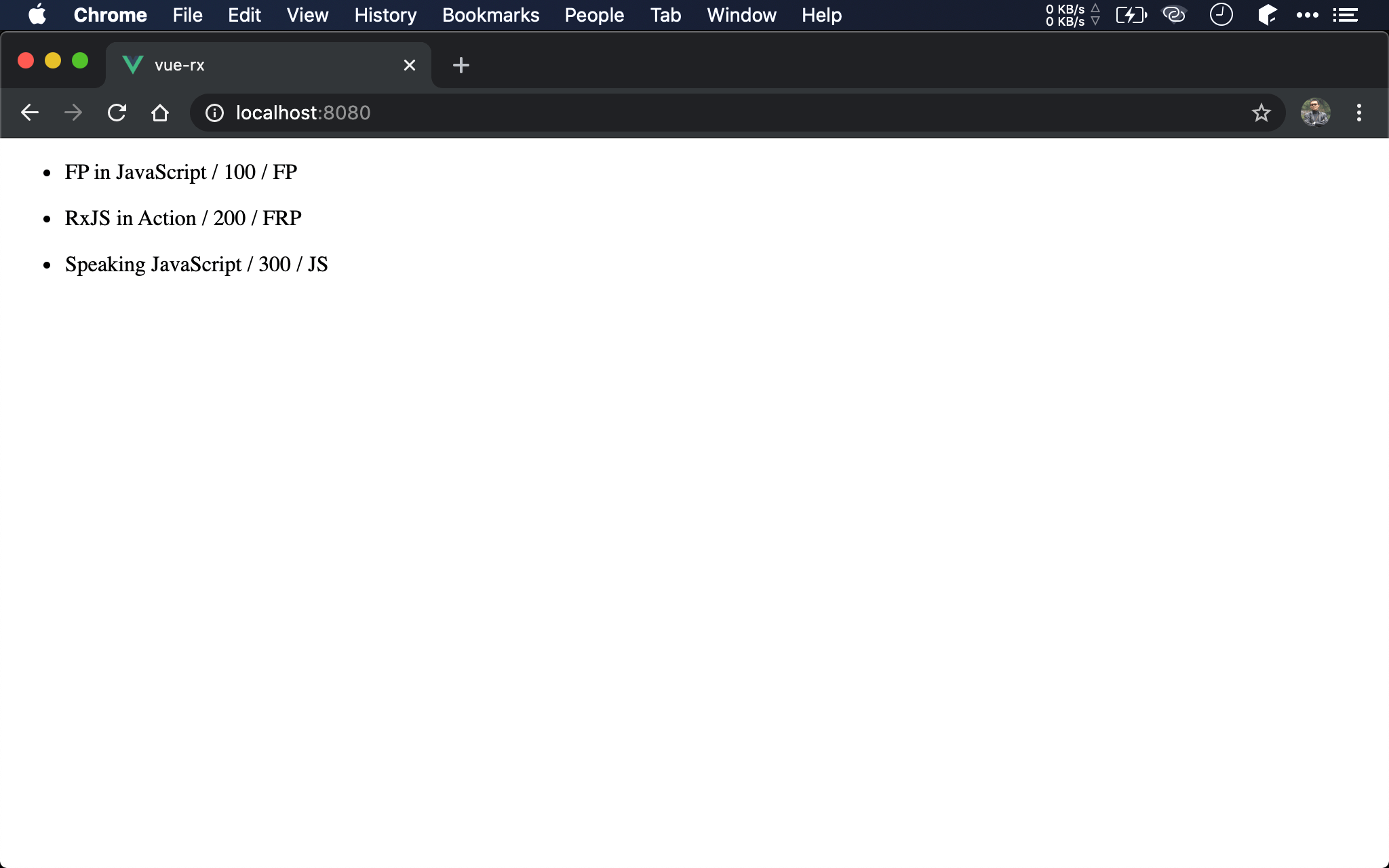
FP、FRP 與 JS 並不是從單一 API 取得,而是呼叫另外一個 API。
Double Side Effect
<template>
<div>
<ul v-for="(x, i) in books" :key="i">
<li>{{ x.title }} / {{ x.price }} / {{ categories[i] }}</li>
</ul>
</div>
</template>
<script>
import { ajax } from 'rxjs/ajax'
import { forkJoin } from 'rxjs'
import { map, pluck, share } from 'rxjs/operators'
let fetchBooks$ = ajax('http://localhost:3000/books')
let fetchCategory$ = x => ajax(`http://localhost:3000/categories/${x.categoryId}`)
let mounted = function() {
let books$ = fetchBooks$.pipe(
pluck('response'),
share()
)
books$.subscribe(x => this.books = x)
books$.pipe(
map(x => x.map(x => fetchCategory$(x))),
).subscribe(x => forkJoin(x).subscribe(x => {
this.categories = x.map(x => x.response.value)
}))
}
export default {
name:'App',
data: () => ({
books: [],
categories: []
}),
mounted
}
</script>
35 行
data: () => ({
books: [],
categories: []
}),
由於需呼叫兩個 API,直覺會使用兩個 side effect。
19 行
let books$ = fetchBooks$.pipe(
pluck('response'),
share()
)
呼叫第一個 API 取得 Object Array Observable,內含 title 與 price property,將使用 categoryId 呼叫第二個 API。
因為稍後會使用兩次 books$ Observable,為避免產生兩次 API request,所以特別加上 share() operator。
24 行
books$.subscribe(x => this.books = x)
使用 subscribe() 寫下第一個 side effect: books data。
26 行
books$.pipe(
map(x => x.map(x => fetchCategory$(x))),
)
最直覺會使用 map() 產生新 Observable,但由於 x 為 Array,所以必須再使用 Array 的 map() 改變其內部值。
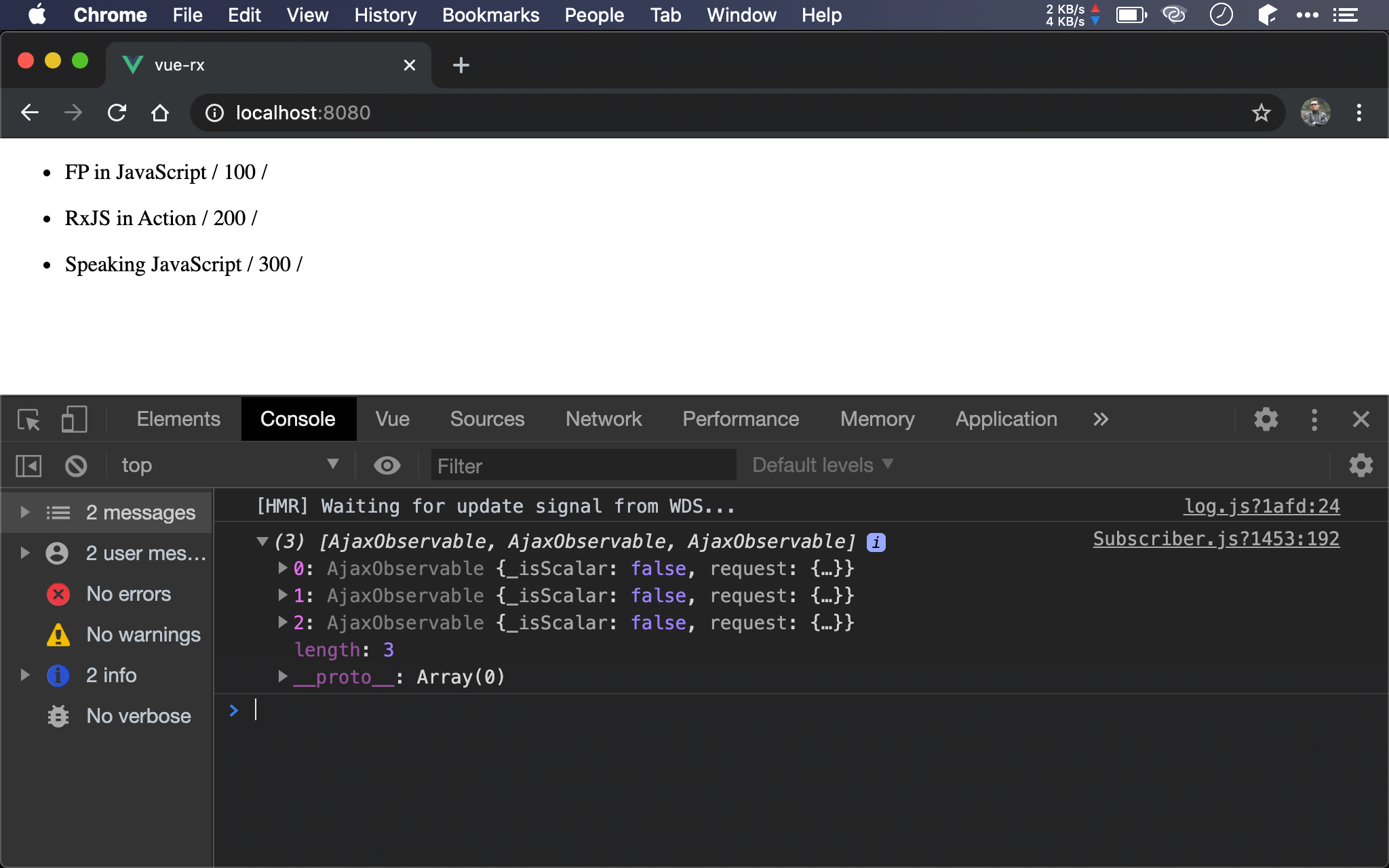
由於 ajax() 回傳 Observable,目前結果為 Observable Array,這正是使用 forkJoin() 時機。
forkJoin()
Observable 版的Promise.all(),可將 Observable Array 成為 Array
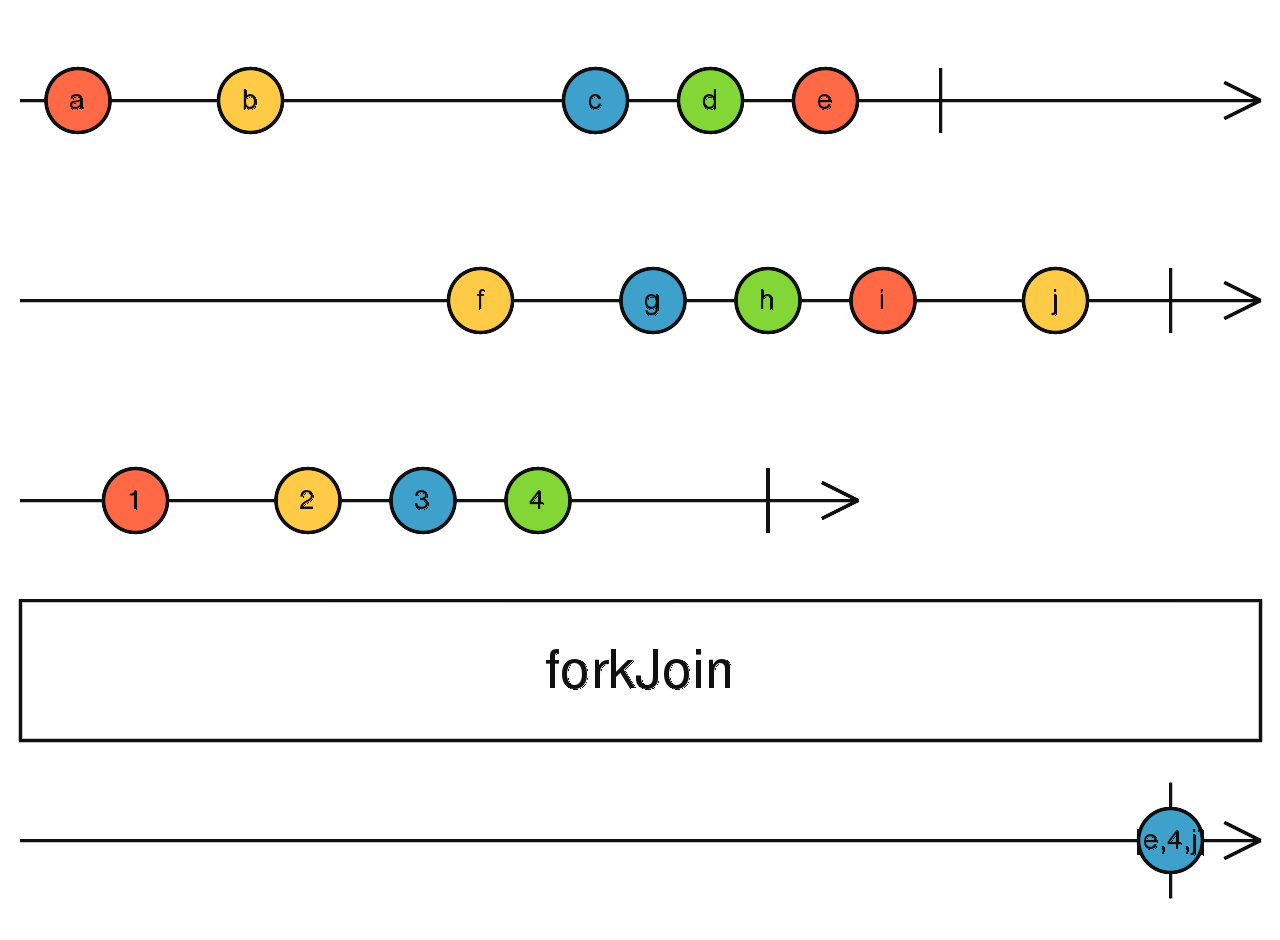
28 行
.subscribe(x => forkJoin(x).subscribe(x => {
this.categories = x.map(x => x.response.value)
}))
x 為 Array,forkJoin() 之後為新的 Observable Array,再次使用 subscribe() 取得內部 Array,因此使用 Array 的 map() 取得 response 的 value。
這是 RxJS 最原始使用方式,但由於在
subscribe()中呼叫forkJoin(),因此出現了 nested subscribe,很明顯這種寫法很糟糕
Refactoring
<template>
<div>
<ul v-for="(x, i) in books" :key="i">
<li>{{ x.title }} / {{ x.price }} / {{ categories[i] }}</li>
</ul>
</div>
</template>
<script>
import { ajax } from 'rxjs/ajax'
import { forkJoin } from 'rxjs'
import { map, pluck, share } from 'rxjs/operators'
let fetchBooks$ = ajax('http://localhost:3000/books').pipe(
pluck('response')
)
let fetchCategory$ = x => ajax(`http://localhost:3000/categories/${x.categoryId}`).pipe(
pluck('response', 'value')
)
let mounted = function() {
let books$ = fetchBooks$.pipe(
share()
)
books$.subscribe(x => this.books = x)
books$.pipe(
map(x => forkJoin(x.map(x => fetchCategory$(x))))
).subscribe(x => console.log(x))
}
export default {
name:'App',
data: () => ({
books: [],
categories: []
}),
mounted
}
</script>
29 行
books$.pipe(
map(x => forkJoin(x.map(x => fetchCategories$(x))))
).subscribe(x => console.log(x))
之前寫法最少有兩點值得先改善:
- 第二個 API 太晚從
response.value取出值,應該在ajax()之後直接在pipe()內使用pluck() x.map()回傳就是 Observable Array,可立即使用forkJoin()處理,這樣可以省下一個subscribe()
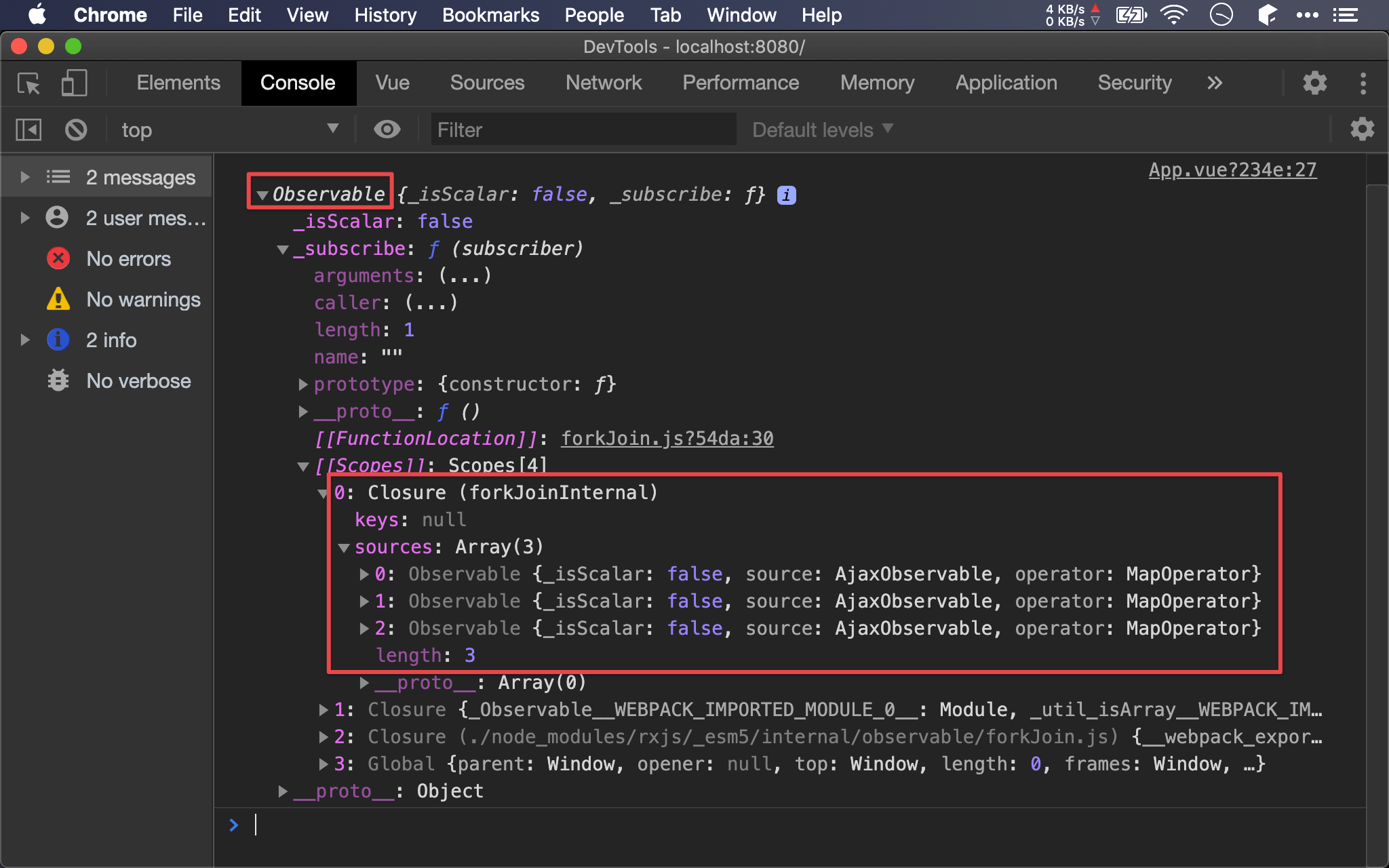
這樣會發現結果為 Observable,且其 subscribe() 內的 x 仍然是 Observable,最後其內部才是 Observable Array。
這是因為 map() 本身回傳 Observable,且 forkJoin() 亦會回傳 Observable,因此造成 Observable of Observable。
flatMap()
<template>
<div>
<ul v-for="(x, i) in books" :key="i">
<li>{{ x.title }} / {{ x.price }} / {{ categories[i] }}</li>
</ul>
</div>
</template>
<script>
import { ajax } from 'rxjs/ajax'
import { forkJoin } from 'rxjs'
import { flatMap, pluck, share } from 'rxjs/operators'
let fetchBooks$ = ajax('http://localhost:3000/books').pipe(
pluck('response')
)
let fetchCategory$ = x => ajax(`http://localhost:3000/categories/${x.categoryId}`).pipe(
pluck('response', 'value')
)
let mounted = function() {
let books$ = fetchBooks$.pipe(
share()
)
books$.subscribe(x => this.books = x)
books$.pipe(
flatMap(x => forkJoin(x.map(fetchCategory$)))
).subscribe(x => this.categories = x)
}
export default {
name:'App',
data:() => ({
books:[],
categories:[]
}),
mounted
}
</script>
29 行
books$.pipe(
flatMap(x => forkJoin(x.map(fetchCategory$))
)
根據使用 Array 經驗,只要出現 Array of Array 時,在 ECMAScript 會使用 Array.prototype.flatMap(),在 Ramda 會使用 chain() 將 Array 攤平,同樣道理,當出現 Observable of Observable 時,也可使用 flatMpa() 將 Observable 攤平。
flatMap()
將 Observable of Observable 攤平成 Observable
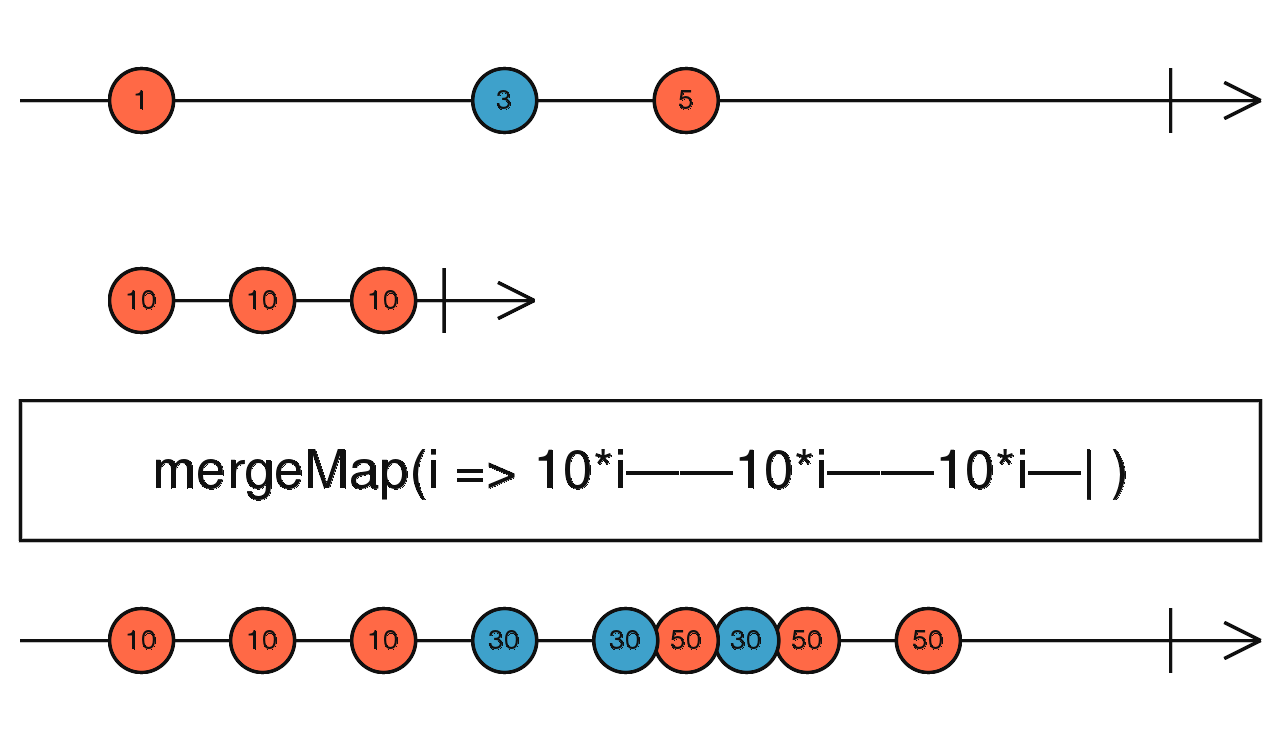
flatMap() 也稱為 mergeMap()。
tap()
<template>
<div>
<ul v-for="(x, i) in books" :key="i">
<li>{{ x.title }} / {{ x.price }} / {{ categories[i] }} </li>
</ul>
</div>
</template>
<script>
import { ajax } from 'rxjs/ajax'
import { forkJoin } from 'rxjs'
import { flatMap, pluck, tap } from 'rxjs/operators'
let fetchBooks$ = ajax('http://localhost:3000/books').pipe(
pluck('response')
)
let fetchCategory$ = x => ajax(`http://localhost:3000/categories/${x.categoryId}`).pipe(
pluck('response', 'value')
)
let mounted = function() {
fetchBooks$.pipe(
tap(x => this.books = x),
flatMap(x => forkJoin(x.map(fetchCategory$)))
).subscribe(x => this.categories = x)
}
export default {
name:'App',
data: () => ({
books: [],
categories: []
}),
mounted
}
</script>
24 行
tap(x => this.books = x),
Side effect 不是只能用 subscribe() 而已,也可使用 tap() 使 pipeline 不中斷,也不用建立新的 Observable,因此連 share() 都省了。
Single Side Effect
<template>
<div>
<ul v-for="(x, i) in books" :key="i">
<li>{{ x.title }} / {{ x.price }} / {{ x.category }} </li>
</ul>
</div>
</template>
<script>
import { ajax } from 'rxjs/ajax'
import { forkJoin } from 'rxjs'
import { flatMap, pluck, map } from 'rxjs/operators'
let fetchBooks$ = ajax('http://localhost:3000/books').pipe(
pluck('response')
)
let fetchCategory$ = x => ajax(`http://localhost:3000/categories/${x.categoryId}`).pipe(
pluck('response', 'value'),
map(category => ({...x, category}))
)
let mounted = function() {
fetchBooks$.pipe(
flatMap(x => forkJoin(x.map(fetchCategory$)))
).subscribe(x => this.books = x)
}
export default {
name:'App',
data: () => ({
books: []
}),
mounted
}
</script>
18 行
let fetchCategory$ = x => ajax(`http://localhost:3000/categories/${x.categoryId}`).pipe(
pluck('response', 'value'),
map(category => ({...x, category}))
)
我們都知道 FP 強調盡量減少 side effect,可能由兩個 side effect 減少成單一 side effect 嗎 ?
在原本 fetchCategory() 內順便 map() 成新的包含 category property 的 book,這也是 HTML template 所預期的最後結果。
26 行
.subscribe(x => this.books = x)
如此只要單一 subscribe() 即可。
Subscription
<template>
<div>
<ul v-for="(x, i) in books$" :key="i">
<li>{{ x.title }} / {{ x.price }} / {{ x.category }} </li>
</ul>
</div>
</template>
<script>
import { ajax } from 'rxjs/ajax'
import { forkJoin } from 'rxjs'
import { flatMap, pluck, map } from 'rxjs/operators'
let fetchBooks$ = ajax('http://localhost:3000/books').pipe(
pluck('response')
)
let fetchCategory$ = x => ajax(`http://localhost:3000/categories/${x.categoryId}`).pipe(
pluck('response', 'value'),
map(category => ({...x, category}))
)
let subscriptions = function() {
let books$ = fetchBooks$.pipe(
flatMap(x => forkJoin(x.map(fetchCategory$)))
)
return { books$ }
}
export default {
name:'App',
subscriptions
}
</script>
23 行
let subscriptions = function() {
let books$ = fetchBooks$.pipe(
flatMap(x => forkJoin(x.map(fetchCategory$)))
)
return { books$ }
}
也可改用 Vue-rx 的 subscription() 取代 subscribe(),如此連 Vue 的 data 與 this 都不用使用,也可安心使用 arrow function,更有 FP 味道。
Ramda
<template>
<div>
<ul v-for="(x, i) in books$" :key="i">
<li>{{ x.title }} / {{ x.price }} / {{ x.category }} </li>
</ul>
</div>
</template>
<script>
import { ajax } from 'rxjs/ajax'
import { forkJoin } from 'rxjs'
import { flatMap, pluck, map } from 'rxjs/operators'
import { compose, map as fmap } from 'ramda'
let fetchBooks$ = ajax('http://localhost:3000/books').pipe(
pluck('response')
)
let fetchCategory$ = x => ajax(`http://localhost:3000/categories/${x.categoryId}`).pipe(
pluck('response', 'value'),
map(category => ({...x, category}))
)
let toCategory = compose(forkJoin, fmap(fetchCategory$))
let subscriptions = function() {
let books$ = fetchBooks$.pipe(
flatMap(toCategory)
)
return { books$ }
}
export default {
name:'App',
subscriptions
}
</script>
24 行
let toCategory = compose(forkJoin, fmap(fetchCategory$))
可將 forkJoin() 與 map() 由 compose() 組合成 toCategory()。
Ramda 的
map()與 RxJS 的map()同名,因此將 Ramda 的map()取別名為fmap()
28 行
flatMap(toCategory)
如此 flatMap() 的 callback 也 point-free 了。
Conclusion
- 當寫出 nested subscribe 時,一定是 something wrong,試著調整 operator 使用順序,避免不必要的 subscribe
- 可能一開始不會發現該使用
flatMap(),一旦出現 Observable of Observable 時,就是該使用flatMap()時機 - 當 RxJS 與 Ramda 搭配時,Ramda 可用來 point-free RxJS operator 的 callback 部分
forkJoin()不是 operator 一直是我很疑惑的設計,這使的forkJoin()無法與其他 RxJS operator 組合,但意外發現卻可與 Ramda function 組合